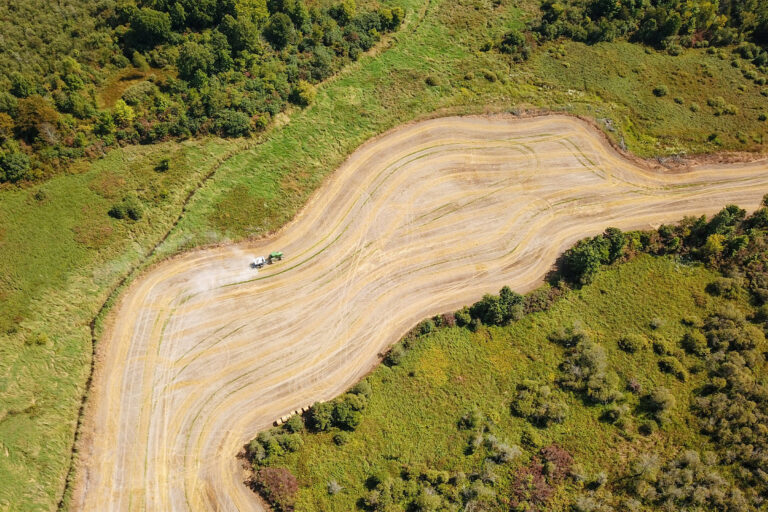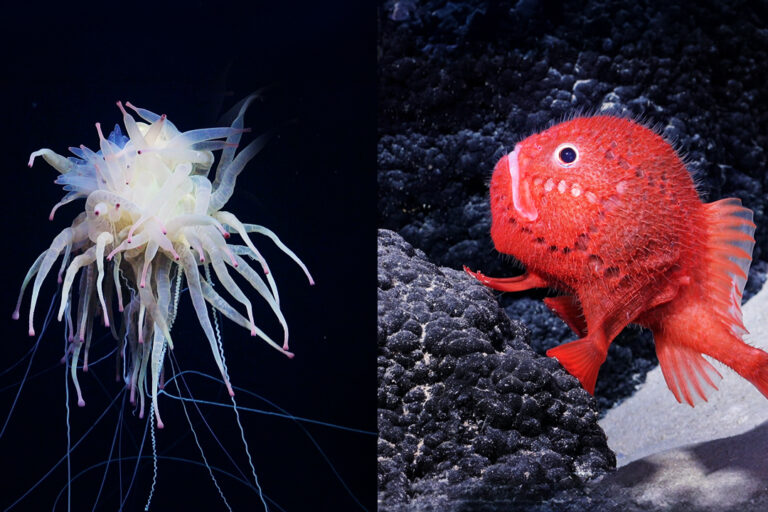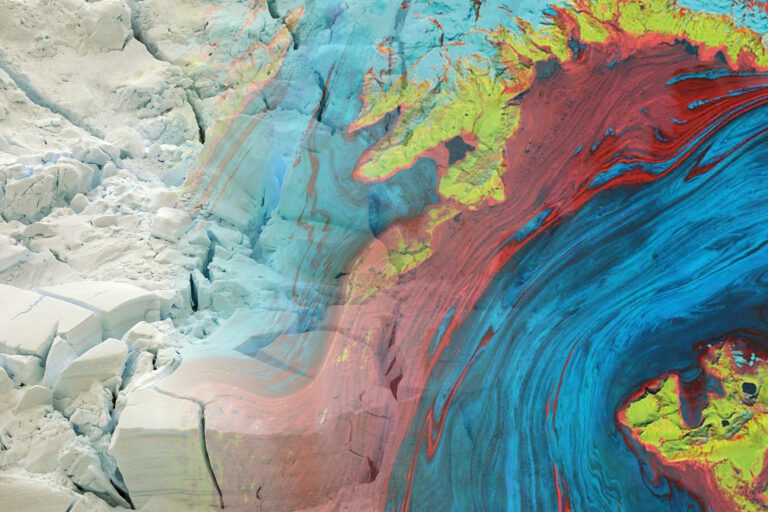
- Natural rock weathering is a fundamental part of Earth’s carbon cycle but occurs over thousands of years. Enhancing this cycle by spreading fine volcanic rock on agricultural land is a form of geoengineering that could speed up this process and permanently lock away carbon dioxide within decades.
- Startups and research programs are underway across the globe to explore the effectiveness and risks of this climate solution. Spreading rocks such as basalt can sequester carbon and benefit soils, with some studies showing crop yield increases.
- If scaled up, enhanced rock weathering could store gigaton levels of carbon in the future, according to early research. But myriad challenges and uncertainties remain, not least of which is how to accurately calculate and verify how much carbon is being stored, and for how long.
- Some companies are already pushing ahead with deployment, with the idea of profiting from carbon credits, but experts caution that long-term studies are needed to ensure the technique’s efficacy, sustainability and environmental safety.
It sounds like a simple solution: Spread some crushed silicate rock atop the world’s vast agricultural lands to absorb atmospheric carbon and thereby tackle climate change at a large scale. But many challenges and questions abound regarding the technique.
Known as enhanced rock weathering (ERW) this carbon dioxide removal (CDR) climate solution, a form of geoengineering, is on the rise as startups and established companies plow ahead with small-scale deployments around the globe.
Enhanced rock weathering aims to replicate a natural part of Earth’s carbon cycle: Silicate rock, such as volcanic basalt, is spread over agricultural land, where exposure to precipitation triggers chemical reactions that “draw down” CO2 from the atmosphere, converting it to carbonates.
These carbonates blend with, and filter down through, soils, until they are washed into rivers and eventually oceans, where they’re locked away for thousands of years. At least that’s the theory.
Proponents describe the ERW process as a “win-win” that can store atmospheric CO2, while simultaneously helping farmers enrich their lands; when the silicates break down, they release minerals and nutrients, balancing pH and nourishing soils, which some studies suggest can boost crop yields.
Research also suggests that if deployed at scale, enhanced rock weathering could lock away billions of tons of carbon dioxide, with some of the world’s largest emitters — such as the U.S., China, India and Brazil — showing the greatest CO2 storage potential due to their extensive agricultural lands and potential weathering rates.
Unlike most other geoengineering methods, enhanced rock weathering projects are already underway and claiming carbon storage at the kiloton scale; these are small amounts, but provide proof of concept, proponents say.
The positive results of these small-scale field trials are helping build hype in support of the fledgling rock weathering industry. Companies such as Microsoft and British Airways are already pumping millions of dollars into the effort by buying up future-based carbon credits.
But scientists remain cautious and raise numerous questions regarding long-term environmental concerns, costs, logistics, and especially the means for reliably monitoring and verifying the volume of carbon stored. Like other geoengineering schemes, the devil is in the details.

Enhanced weathering’s rocky potential
Unlike other carbon dioxide removal methods (such as direct air capture or carbon capture and storage that require massive amounts of infrastructure), ERW can employ existing technology and tap unused stocks of mined and quarried rock.
“Enhanced rock weathering has large potential, perhaps comparable to other technologies, as the infrastructure that will be needed is often already available,” says Salvatore Calabrese, an assistant professor at Texas A&M University.
That’s a significant mark in its favor. But dig deeper and the implementation of this theoretically sound climate solution becomes more complex and daunting. A major hurdle facing companies venturing into this space is determining if it’s working at all.
Importantly, how does one cost effectively and accurately track and calculate carbon stored? To do so, researchers must know how fast crushed silicates will react in various soils. But “That’s only the first piece of the puzzle, [because then you] have to complete the sequestration process,” says Calabrese, who adds, “What happens [next] to weathering products as they move from soils to the ocean is largely unknown.”
There’s also the question of precisely what kind of stone to use. Companies are experimenting with basalt, wollastonite, olivine and crushed concrete, which all weather and absorb carbon at different rates. And once spread over farmland, many factors can influence weathering rates and carbon storage potential, including climate and soil pH.
“When you’re applying over large areas, the soils are different,” explains Calabrese. “Within your field you have these heterogeneities that translate into one measurement taken at one point [which] can be very, very different from another measurement taken on the other side of the field.”
Getting these calculations right requires huge soil sampling efforts and accounts for a large portion of operational costs, up to 50% in some cases. Consequently, costs of ERW carbon credits remain high — between $300 and $600 per credit — a price that must fall if the sector is to succeed in the long term, according to experts. ERW Global standards and protocols have been devised, but carbon counting methodologies still vary widely between companies.

Ben Westcott, chief operations officer at UNDO, a rock weathering company based in the U.K., says his firm’s measurements take a “broad spectrum approach” including soil samples and modeling that allow credits to be issued currently at a 90% confidence level. “We build up a picture over time of how material is breaking down, which is one component, and also what the products of that breakdown are,” he says.
In 2023, UNDO spread more than 141,000 metric tons of crushed basalt rock on U.K. farms, an amount that should, over time, draw down about 37,000 metric tons of carbon dioxide, Westcott says.
Other companies, such as U.S.-based Lithos, aim to lock down hundreds of thousands of tons of CO2 within the next few years based on their own carbon counting methods. Isotope analysis is considered one highly accurate method, though costs are high in developed countries. In India, ERW company Alt Carbon states that process sampling is far more cost effective there, offering a competitive advantage.
Researchers remain cautious: Promising millions of tons of carbon removal with ERW, they say, needs to be underpinned by robust, transparent and standardized monitoring and verification. Plowing forward in the absence of deep research and accurate measurements risks undermining investor trust in a global carbon market that has been shaken by past major carbon offsetting scandals.
David Beerling, director of the Leverhulme Centre for Climate Change Mitigation at the University of Sheffield, U.K., says he feels certain that in the future highly effective and cheaper measurement methods will be developed, but that the sector should not move too quickly without quality methods in place.
“I think we have to be super cautious that deployment of some of these companies doesn’t move ahead of developing rigorous [monitoring, reporting and verification] approaches,” Beerling, who is also a minority UNDO shareholder, says.
ClimeRock, a recently launched ERW firm in France, doesn’t as yet sell carbon offsets, because the business lacks the mechanisms to concretely back claims of carbon drawdown, says company co-founder Arthur Chabot. “We need to be really, really, really sharp and careful before declaring to have absorbed an amount of CO2,” he says.


Understanding ERW from soil to sea
Another challenge is quantifying carbon losses during the weathering process. Proving that carbon dioxide is sequestered in the soil is one thing, but to be effective, that carbon must stay locked up as it travels via rivers to the sea.
Kirsty Harrington, a research associate at the Research Centre for Carbon Solutions at Heriot-Watt University, U.K., says that today, while some modeling of this journey has been accomplished, there’s little field research on enhanced rock weathering and rivers.
Studies by her team determined that some rivers in the U.K., particularly those in the chalk region of southeast England with high pH and alkalinity, could re-release a portion of sequestered CO2 due to carbonate precipitation, ultimately lessening the net removal.
“We’re not really seeing much of a signal from any of the field trials in the rivers at the moment, because the carbonates haven’t even got there yet,” Harrington says. It can take several years for deposited silicates to permeate soils and reach watercourses. More long-term testing is needed, she adds, including assessments of potential environmental impacts caused by various silicates as they make changes to pH or river chemistry. Such changes, when ERW is done on a large scale, could have some effects on aquatic biodiversity.
This soil-to-sea problem also makes long-term carbon sequestration calculations more complicated, plaguing current measurements with unknowns.
“I think we’ll have to think about enhanced weathering at a catchment scale, rather than a national scale, because there are so many variations to consider,” Harrington says, some of which include soil type, temperature, climate, and the presence of microbes and plants.


Balancing benefits and risks in the tropics
Carbon storage aside, one attraction of ERW to entrepreneurs is its potential to support farmers and promote soil health, particularly in developing tropical countries where it’s potential is being touted. In the tropics, climatic factors, reliable rainfall and acidic soils can all speed up the silicate weathering process, potentially drawing down CO2 much faster than in temperate zones.
Crop studies conducted and published thus far, primarily based on trials in temperate zones, suggest silicate rock application can enhance yields to a significant degree. That’s because the minerals locked within can stabilize soil pH, potentially reducing demand for the use of artificial fertilizers by improving soil health. ERW companies are currently providing rocks free of charge to farmers in countries such as the U.S., U.K., Kenya, India and Colombia. Scaling up could offer additional sources of farm income via climate finance.
In Kenya, Flux Carbon, an ERW company, is working with smallholders to use rock weathering to build climate resilience with farmers lacking access to fertilizers. Small-scale trials have proved positive, says company CEO Sam Davies, whose firm also partnered with the United Nations on a trial project.
In Davies’s view, rock weathering has vast potential in Africa, particularly for smallholder farmers. Building on Flux’s project in Kenya, the firm plans to conduct future trials in Nigeria and Cameroon. “We are essentially transitioning now from the pilot phase into small-scale deployment phase,” says Davies.
Likewise in India, where the founders of Alt Carbon say that Darjeeling tea farmers who have been hammered by climate change stand to benefit greatly from ERW. “We’ve seen between 15 to 20% yield increases as of now,” says Sparsh Agarwal, co-founder of Alt Carbon. The company and other firms are also experimenting with silicate rock additives such as enzymes that could speed up the weathering process and serve as an additional soil nutrient.
But enhanced rock weathering is not without risks. Concerns have arisen, for example, because fast-weathering olivine is also high in toxins such as chromium and nickel, raising the specter of long-term soil, water and crop contamination. That’s led to basalt taking a prime place among developers, even though it takes longer — around two decades — to complete its weathering process.


Chabot emphasizes the need for careful diligence in applying any material in large amounts to farmland, citing the decades-long and widespread practice of spreading sewage sludge as a soil amendment in the U.S. and elsewhere. Only many years later has it become apparent that this sludge, though nutrient-rich, is also often contaminated with long-lived toxic PFAS, known as “forever chemicals.”
“We don’t want that with enhanced rock weathering. We want to do things that are safe for food, for soils and for ecosystems,” Chabot says. That “requires lots of care, because when you have put something on the soils, it’s irreversible. It cannot be undone.”
“That’s another reason why field trials should monitor very [thoroughly], not just for sequestration, but also for the potential side effects that their deployments can have,” agrees Calabrese. Experts note that long-term field trials tracking both carbon potential and accumulation of contaminants is currently lacking.
Scaling up ERW also comes with sustainability concerns. Currently, companies are making use of ample supplies of leftover rock at existing quarries and mining operations. But if the technique is to reach projected scales of billions of tons to achieve significant carbon storage, then astronomical amounts of stone will need to be quarried, ground and transported to farms.
This, experts say, may have serious land, water and biodiversity impacts, as rock is extracted and energy is used to crush and truck it to the fields. A recently published paper indicates that for this reason, ERW is not a one-size-fits-all climate solution. The paper found that economic, environmental and social sustainability could vary widely in the U.S., U.K., France, Germany, Brazil, Russia, India and China. Environmental concerns, for example, are likely to be highest in the latter three nations due in part to their weaker regulatory laws.

Weathering the hype
ERW momentum continues building, based largely on rapidly intensifying climate change, and the hope that the technology can quickly play a role in curbing the crisis. How large that role may be, or how long deployment might take, and with what unforeseen impacts and costs, remains to be seen.
Beerling emphasizes that researchers and companies need to move beyond the current four-year trials, to longer-term studies that resolve outstanding uncertainties. His own research group currently operates the longest-running enhanced weathering project. Based in the U.K., it’s planning an eight-year trial: “People want to know how this works if you keep doing it year on year … How does it affect yields? How does it affect soils? How does the [carbon storage] change over time?”
Other experts agree that caution is needed as companies rush to scale up. Harrington, for example, says she believes that enhanced rock weathering has potential as a climate solution, but she underlines the many unknowns and uncertainties as ERW charts its path.
Answers to ERW benefit-and-risk questions are sorely needed, agrees Robert Hilton, a geochemist at the University of Oxford, but that doesn’t negate the urgent need to drastically cut emissions now: “Carbon dioxide removal can be applied later than emission cuts, but those cuts need to happen,” he says.

Banner image: Wollastonite spreading in Canada. Several types of rock can be used for ERW. Some, such as olivine, while weathering rapidly, may also release toxic materials. Companies say rock types are tested prior to spreading. Image courtesy of UNDO.
Geoengineering gains momentum, but governance is lacking, critics say
Citations:
Hartmann, J., West, A. J., Renforth, P., Köhler, P., De La Rocha, C. L., Wolf‐Gladrow, D. A., … Scheffran, J. (2013). Enhanced chemical weathering as a geoengineering strategy to reduce atmospheric carbon dioxide, supply nutrients, and mitigate ocean acidification. Reviews of Geophysics, 51(2), 113-149. doi:10.1002/rog.20004
Skov, K., Wardman, J., Healey, M., McBride, A., Bierowiec, T., Cooper, J., … Liu, X. (2024). Initial agronomic benefits of enhanced weathering using basalt: A study of spring oat in a temperate climate. PLOS ONE, 19(3), e0295031. doi:10.1371/journal.pone.0295031
Beerling, D. J., Kantzas, E. P., Lomas, M. R., Wade, P., Eufrasio, R. M., Renforth, P., … Banwart, S. A. (2020). Potential for large-scale CO2 removal via enhanced rock weathering with croplands. Nature, 583(7815), 242-248. doi:10.1038/s41586-020-2448-9
Haque, F., Santos, R. M., Dutta, A., Thimmanagari, M., & Chiang, Y. W. (2019). Co-benefits of wollastonite weathering in agriculture: CO2 sequestration and promoted plant growth. ACS Omega, 4(1), 1425-1433. doi:10.1021/acsomega.8b02477
Harrington, K., Henderson, G., & Hilton, R. (2024). Comparing potential carbon dioxide removal fluxes from enhanced rock weathering with baseline fluxes in the UK. EGU General Assembly. doi:10.5194/egusphere-egu24-12948
Harrington, K. J., Hilton, R. G., & Henderson, G. M. (2023). Implications of the riverine response to enhanced weathering for CO2 removal in the UK. Applied Geochemistry, 152, 105643. doi:10.1016/j.apgeochem.2023.105643
Kantzas, E. P., Val Martin, M., Lomas, M. R., Eufrasio, R. M., Renforth, P., Lewis, A. L., … Beerling, D. J. (2022). Substantial carbon drawdown potential from enhanced rock weathering in the United Kingdom. Nature Geoscience, 15(5), 382-389. doi:10.1038/s41561-022-00925-2
DeLucia, E. H., Kantola, I. B., Masters, M. D., Blanc-Betes, E., Epihov, D., & Beerling, D. J. (2022). Co-benefits for agriculture of enhanced rock weathering as a carbon dioxide removal strategy. AGU Fall Meeting Abstracts. Retrieved from https://ui.adsabs.harvard.edu/abs/2022AGUFMSY36A..04D/abstract
Peplow, M. (2024). Enzymes boost ‘rock weathering’ to trap CO2 in soil. Nature Biotechnology, 42(9), 1326-1328. doi:10.1038/s41587-024-02380-3
Oppon, E., Koh, S. L., & Eufrasio, R. (2024). Sustainability performance of enhanced weathering across countries: A triple bottom line approach. Energy Economics, 136, 107722. doi:10.1016/j.eneco.2024.107722
Baek, S. H., Kanzaki, Y., Lora, J. M., Planavsky, N., Reinhard, C. T., & Zhang, S. (2023). Impact of climate on the global capacity for enhanced rock weathering on croplands. Earth’s Future, 11(8). doi:10.1029/2023ef003698
Beerling, D. J., Epihov, D. Z., Kantola, I. B., Masters, M. D., Reershemius, T., Planavsky, N. J., … Banwart, S. A. (2024). Enhanced weathering in the US corn belt delivers carbon removal with agronomic benefits. Proceedings of the National Academy of Sciences, 121(9). doi:10.1073/pnas.2319436121
Vakilifard, N., Kantzas, E. P., Edwards, N. R., Holden, P. B., & Beerling, D. J. (2021). The role of enhanced rock weathering deployment with agriculture in limiting future warming and protecting coral reefs. Environmental Research Letters, 16(9), 094005. doi:10.1088/1748-9326/ac1818
Sovacool, B. K., Baum, C. M., Low, S., & Fritz, L. (2023). Coral reefs, cloud forests and radical climate interventions in Australia’s wet tropics and Great Barrier Reef. PLOS Climate, 2(10), e0000221. doi:10.1371/journal.pclm.0000221
FEEDBACK: Use this form to send a message to the author of this post. If you want to post a public comment, you can do that at the bottom of the page.







